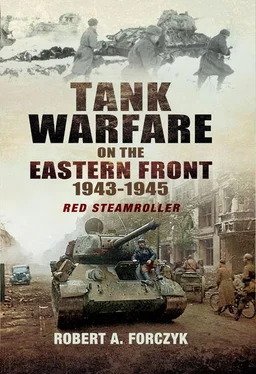The StuG-III crewmen managed to run back to their unit and soon thereafter, successfully towed the immobilized assault gun under fire and brought it to a friendly assembly area. Well-trained crews can hook up tow cables in seconds, although if the final drive is not disconnected – which requires opening the back deck – the transmission will likely be damaged when the vehicle is towed.
Once the SS-Panzerkorps broke through the Soviet defences south of Kharkov, it swung to the west and began to envelop the city while von Knobelsdorff’s XXXXVIII Panzerkorps advanced toward the eastern side of the city with the 6. and 11.Panzer-Divisionen. Hoth hoped to encircle the city and avoid sending his mechanized forces into urban combat, but Hausser and his troops were eager to avenge their earlier retreat from the city. Between 10–14 March, Hausser’s SS-Panzerkorps fought its way into Kharkov and gradually overcame the uncoordinated Soviet resistance in vicious street fighting. On 14 March, the city was in German hands and Golikov’s shattered Voronezh Front was in headlong retreat. Rybalko’s 3TA was effectively destroyed.
After securing Kharkov, the third phase of von Manstein’s counter-offensive began with the advance north toward Belgorod. The spring thaw was beginning, melting some snow and turning the roads into deep mud. Von Manstein wanted to seize as many follow-on objectives as possible before the weather and eventual Soviet reinforcements could halt his advance. It was Großdeutschland which made the most progress, smashing into Kazakov’s battered 69th Army and rolling it up with a one-division mini- Blitzkrieg . On 13 March, the Großdeutschland captured Borisovka, east of Belgorod. Golikov brought Kravchenko’s understrength 5GTC over to stop the Großdeutschland ’s advance as well as the 3rd Guards Tank Corps. The Stavka even provided Golikov with Badanov’s 2nd Guards Tank Corps (formerly the 24th Tank Corps), which had been virtually destroyed in the Tatsinskaya Raid in December 1942; although re-equipped, this formation was unready for combat. The Graf Strachwitz’s well-trained panzer crews destroyed these ill-trained Soviet units piecemeal in a series of actions between 13–18 March that were reminiscent of the heady days of Barbarossa , except for the mud; the Panzer-Regiment Großdeutschland claimed 128 Soviet tanks destroyed in this period. In one action, the enemy simply abandoned their tanks and Großdeutschland captured 15 intact T-34s. Although outnumbered 3–1 or worse, Strachwitz’s panzers completely outclassed their opposition and, unlike the Waffen-SS tankers, knew how to keep their own losses down with proper battlefield reconnaissance. On the night of 14–15 March, the Großdeutschland detected an impending Soviet armoured counter-attack and Strachwitz deployed his panzers in ambush near Borisovka, as related by a German tank platoon leader:
After a quick briefing of the tank commanders on the distribution of fire, radio silence was ordered. The platoon leader gave the order to open fire only on his command. Critical minutes now followed. Barely 1,000 meters away the diesel engines of enemy tanks suddenly roared to life. It wasn’t just the sounds of two or five tanks – there had to be many more.
The morning of 15 March 1943 dawned; the roar of engines slowly drew nearer. The tank commanders spotted the outlines of the first T-34s over on the road. The gunners at their sights were already restless, but in the twilight they could not yet see their targets clearly. They held their breath and sighed with relief when the first T-34 entered their field of view. All the while the loader crouched tensely by his gun, a shell in his hands, two more clamped between his legs; for every second counted… There were already five T-34s in the field of view. Unsuspectingly, the T-34s ground through the snow and mud. Seven were already visible, and their broadsides were too tempting for the gunners.
The T-34s appeared to be uncertain, turning their barrels to the left and to the right; it was good that we were on parallel to them. Every gunner already knew which enemy tank to engage. The first two belonged to the man on the left wing, those behind it to the others echeloned to the right… For a moment, the calm developed after many engagements seemed to be shaken. Then, finally, the order: All tanks… guns up… fire! A loud bang! Then, in a matter of seconds, four – eight – twelve green tracer trails, between them brief radio messages. Then the firing settled down into a few individual rounds. On the enemy side huge jets of flame and smoke. The last T-34 tried to turn around and became bogged down in the process. The crew sprang like cats from the turret, but they were mowed down by our machinegun fire. Our tank drivers waved to each other joyfully. {59}
On 18 March, the SS-Panzerkorps exploded north from Kharkov and captured Belgorod that evening. Over the next several days, the SS-Panzerkorps and Großdeutschland mopped up Soviet remnants in the area, but von Manstein’s offensive was finally brought to a halt by the spring thaw and increasing resistance. Katukov’s 1st Tank Army (1TA) finally arrived north of Belgorod on 23–24 March, along with two other fresh armies from the RVGK, which created the front-line that stabilized for the next three months until the Battle of Kursk. While von Manstein’s ‘Backhand Blow’ is rightly regarded as an operational masterpiece, it also indicated that the character of German mechanized offensives was changing as many of their traditional advantages began to wane. The German Panzertruppen still enjoyed a major edge in tactical skill, but Soviet anti-tank defences were becoming much more robust than in 1941–42 and the Red Army’s tank units were also improved. Von Manstein did succeed in mauling eight of the 20 Soviet tank corps on the Eastern Front, which temporarily deprived the Red Army of the initiative and gave Heeresgruppe Süd a valuable breathing space.
Rokossovsky’s Offensive, 25 February–28 March 1943
Although most of the action in early 1943 was occurring on the southern part of the Eastern Front, the Stavka was eager to put pressure on Generalfeldmarschall Günther von Kluge’s Heeresgruppe Mitte as well in order to tie down German forces and to reclaim territory while the Germans were still hard-pressed. As planning for Operations Gallop and Star proceeded in late January 1943, the Stavka also began developing a plan for the Bryansk Front to attack Generaloberst Rudolf Schmidt’s 2.Panzerarmee’s (2.PzAOK) positions north of Orel and finish off General der Infanterie Walter Weiss’ 2.Armee (2.AOK), which would disrupt Heeresgruppe Mitte’s right flank and assist the advance of Golikov’s Voronezh Front. Furthermore, the Stavka decided that once the Battle of Stalingrad ended, that Rokossovsky’s five armies should redeploy by rail and form a new Central Front to supplement the Bryansk Front’s offensive. Recognizing that Rokossovsky’s armies were not equipped with a great deal of armour to spearhead a breakthrough operation, the Stavka decided to transfer General-leytenant Aleksei G. Rodin’s 2nd Tank Army from the RVGK to Rokossovsky’s new command, as well as the newly-formed 70th Army. Once Rokossovsky seized Orel, the Stavka intended to widen the offensive by including the Western Front. Zhukov optimistically hoped that the concurrent offensives of Vatutin, Golikov and Rokossovsky would prevent the Germans from forming a new front and force them to retreat to the Dnepr.
Heeresgruppe Mitte’s right flank did appear ripe for the picking. There was a thinly-covered area between 2.AOK and 2.PzAOK near Sevsk, 140km southwest of Orel. Although the face of the burgeoning Orel salient was stoutly defended by the XXXXVI Panzerkorps with the 12., 18. and 20.Panzer-Divisionen, General der Panzertruppe Joachim Lemelsen’s XXXXVII Panzerkorps was holding the extreme right flank of 2.PzAOK with just the 137. and 707.Infanterie-Divisionen; the 707.Infanterie-Division was a particularly weak formation that had only been employed in anti-partisan operations and possessed a single artillery battalion and no divisional anti-tank unit. Nor did the battered 2.Armee possess the resources to stop a concerted enemy push westward. Generalmajor Erich Schneider’s 4.Panzer-Division was sent to hold Kursk, but its armoured strength was reduced to a single tank company, plus a few assault guns. As in the winter of 1941–42, the 4.Panzer-Division had so few Panzergrenadiers left that it was forced to create an ad hoc infantry unit from dismounted tankers. The Stavka’s plan was to have the Bryansk Front strike the face of the Orel salient and fix the XXXXVI Panzerkorps, then Rodin’s 2TA and the 70th Army would crush Lemelsen’s XXXXVII Panzerkorps and envelop Orel by driving for Bryansk.
Читать дальше








![John Stieber - Against the Odds - Survival on the Russian Front 1944-1945 [2nd Edition]](/books/405234/john-stieber-against-the-odds-survival-on-the-russian-front-1944-1945-2nd-edition-thumb.webp)



